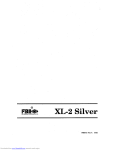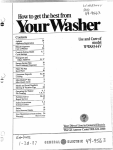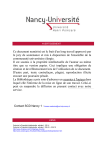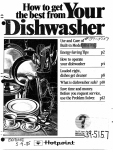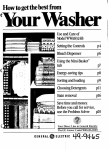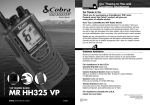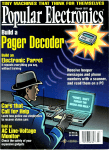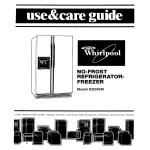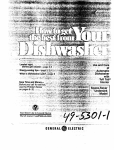Download Hotpoint Dishwasher Dishwasher User Manual
Transcript
Dishwasher
Use and Care of
Btit-in and Convertible
Dishwashers
Loaded ri@t,
dishes get cleaner
p4
Energy-sating tips
inside
tiont cover
Whatis dishwasher stie? p6
How to comect
convertible modek
p7
Save time and money
Before you CW for service,
plo
use the Problem Solver
‘rhe (;E ,\ns\!er [’ent~?
800.626.2000
Contents
Good dishwashing starts
with HOT water . . . . . . ........2
Howtotest water . . . . ........2
Using a rinse agent . . . ........2
Help us
help you...
Read this book and the
separate Operating
Instructions Leaflet carefully
How to choose and use
the right detergent. . . . . . . . . . ..2
They are designed to help you
operate and maintain your new
dishwasher properly.
How to prepare dishes
forwashing . . . . . . . . . . . . . . . . .3
Keep them handy for answers to
your questions.
How to load your
dishwasher. . . . . . . . . . . .. ...4.5
If you don’t understand something
or need more help... Call, toll free:
The GE Answer CenterTM
800.626.2000
consumer information service
or write (include your phone
number):
Consumer Affairs
Hotpoint
Appliance Park
Louisville, KY 40225
What can you wash safely. .. ...6
How to connect electricity
on convertible models. .. ......7
How to connect the
Unicouple on
convertible models . . . ........8
User maintenance
instructions . . . . . . . . . .. ......9
Problem solving . .........10,11
Consumer services ... , .. ....13
Warranty. . . . . . . . . . . Back Cover
Eneqy=saving tips
The power consumption of your
dishwasher can be minimized if
you follow these suggestions:
● Operate the dishwasher only
when it’s full. Let the dishes accumulate in the dishwasher, When
you put in only a partial load, use
the Rinse Hold cycle to rinse off
heavy soils. Be sure to latch the
door when waiting for a full load.
This helps to keep soils moist,
easier to remove.
● Always select the cycle that
uses the least amount of water
that will remove the soil from the
load. See your Operating
Instructions Leaflet.
● If you don’t need your dishes
right away, use your Ene~y-Saver
no.heat feature that turns the
drying heater off automatically.
Dishes dry naturally over a longer
period such as overnight.
Write down the model and
serial numbers.
You’ll find them on a label just
inside the dishwasher door.
These numbers are also on the
Consumer Product Ownership
Registration Card that comes with
your dishwasher. Before sending in
this card, please write these
numbers here:
Model No.
Serial No.
Use these numbers in any
correspondence or service calls
concerning your dishwasher.
If you received a damaged
dishwasher, immediately contact
the dealer (or builder) that sold-you
the dishwasher.
Save time and money...
Y,
before you call for service
Check the Problem Solver (pages
10-11). It lists minor causes of
operating problems that you can
correct yourself. It could save you
an unnecessary service call.
(for ~Cti~M -*
P* 7. This appliam must be
grounded. in m SVent Qf a
malfunc~n w
ing
will
reduq
‘
shock by provw @ P~.@ “-t ,,
resis@nce for eiactrfq m~t This
appliance.
fs~ui~’ti66.@
having
an
conductor and a gr@ndln@pJ@.
The plug must be plugged Into an
appropriate outlet that is instalfed
and grounded in accordance with
alt local codes and ordtna~s.
,-
1
Good dishwashing
starts with HOT water.
You can help prevent
spotting with a rinse
agent.
To get dishes clean and dry you
need hot water. To help you get
water of the proper temperature,
your Hotpoint dishwasher automatically senses the temperature
of the water in the wash cycle and
heats it, if necessary, to the proper
temperature. For good washing
and drying, the entering water
must be at least 120°F. To prevent
dishware damage, inlet water
should not exceed 150°F
A rinse agent makes water flow off
dishes quicker than usual. This
lessens water spotting. Makes
drying faster, too.
Check your water temperature
with a candy or meat thermome.
ter. Turn on the hot water faucet
nearest the dishwasher. Put the
thermometer in a glass and let the
water fill the glass until the temperature stops rising. If the water
temperature is below 120°E adjust
your water heater.
Helpful hints: If outside temperatures are unusually low or if your
water travels a long distance from
heater to dishwasher you may
need to set your heater’s thermostat up. If you have not used hot
water for some time, the water in
the pipes will be cold. Turn on the
hot water faucet at the sink and
allow it to run until the water is
hot. Then start the dishwasher. If
you’ve recently done laundry or run
hot water for showers, give your
water heater time to recover before
operating the dishwasher.
Rinse agents come in either liquid
or solid form. Your dishwasher’s
dispenser (on models so equipped)
uses the liquid form.
Here’s how to fill the rinse agent
dispenser. Unscrew the cap.
Add the liquid rinse agent until
it just reaches the bottom of the
lip inside the dispenser opening.
Replace the cap. The dispenser
automatically releases the rinse
agent into the final rinse water.
If you accidentally spill: Wipe up
the rinse agent with a damp cloth.
Don’t leave the spill in the dishwasher. It can keep your detergent
from working.
If you can7t find any rinse agent,
write:
ECONOMICS LABORATORY INC.
(“JET DRY”)
Osborn Buildina
S~ Paul, Minne;ota 55102
How to choose and use
detergent.
First, use only detergent
specifically made for use in
dishwashers. Other types will
cause oversudsing.
Second, check the phosphate
content. Phosphate helps prevent
hard-water materials from forming
spots or film on your dishes. If
your water is hard (10 grains or
more), your detergent has to work
harder. Detergents with a higher
phosphate level will probably work
better. If the phosphate content is
low (8.7V0 or less), you’ll have to
use extra detergent with hard
water.
Your water department can tell
you how hard your water is. So
can your rural county agent. Or
your area’s water softener company. Just call and ask them how
many “grains” of hardness is in
your water.
How much detergent should you
use? That depends. Is your water
“hard” or “soft?” With hard water, ~
you need extra detergent to get
dishes clean. With soft water, you
need less detergent.
Too much detergent with soft
water not only wastes money, it
can be harmful. It can cause a
permanent cloudiness of glassware, called “etching.” An outside
layer of glass is etched away! Of
course, this takes some time. But
why take a chance when it’s easy
to find out the hardness of your
water.
Your dishwasher’s rinse agent
container holds 41\2 ounces. This
should last about 3 months. Fill as
needed.
2
—.
Keep your detergent fresh and
dry. Under the sink isn’t a good
place to store detergent. Too much
moisture. Don’t put detergent into
the dispenser until you’re ready to
wash dishes, either. (It won’t be
fresh OR dry.)
What you can
leave on dishes.
And what you shouIdn7t.
‘f your detergent gets old or
iumpy, throw it away. It won’t
wash well. Old detergent loses its
power. Lumpy detergent often
won’t dissolve.
You’ll find two detergent
dis~ensers on the inside door of
your dishwasher. Two, because
some cycles use two washes.
If this is your first dishwasher, or if
you’re replacing a much older
model, you may wonder how much
pre-preparation your dishes need.
Actually very little. Pre-rinsing of
normal food soils is not necessary.
With common sense and a little
practice you’ll soon know what
foods to remove. Here are some
guidelines:
1. Scrape off bones, seeds, skins,
toothpicks and other hard solids. It
is also best to remove hard shelled
vegetables, meat trimmings, leafy
vegetables and crusts. Remove
excessive quantities of oil or
grease.
See “Detergent Usage Guide”
below, (Be ;ure the ~ycle Indicator
Dial is at OFF position before
adding detergent.)
T
\
2. Remove large quantities of any
food. Your dishwasher has a builtin soft food disposer that pulverizes soft food bits and flushes
them away. It can handle sma//
amounts of soft foods, but large
amounts of food as soft as
mashed potatoes or applesauce
will be difficult to handle.
3. Try to remove food scraps and
place dishes in dishwasher before
soil has a chance to dry and
become hard. Dishes with dried-on
soil are more difficult to wash and
may not come clean in the Normal
Cycle. Remember to use your
Rinse Hold Cycle for small
“holding” loads.
Note: The foods mentioned above
are for examples only. Other foods
not mentioned may also need to
be removed from your dishes. You
may also want to consider
removing foods such as mustard,
mayonnaise, vinegar, lemon juice
and other foods that can cause
discoloration of stainless steel if
allowed to remain on dishes for a
long period of time.
When using the POWER SCRUB
cycle (on models so equipped)
less preparation is required before
loading. The Power Scrub cycle
can wash heavily-soiled dishes and
remove dried-on and baked-on
soils from pots, pans and casseroles. Items with burned-on soils
will not come clean. And the
dishwasher cannot remove burn
marks or restore fading caused by
overheating during cooking.
/
Close the main cup.
NOTE: Detergent cup may be
opened manually with no harm.
Detergent Usage Guide
SO~ WATER
(O-3 grains hardness)
CYCLES
Delicate and
Light Wash cycles
Main Cup
Open Cup
1 Tablespoon ~ 1 Tablespoon
minimum
minimum
1 Tablespoon
None
minimum
Rinse Hold cycle
Use no detergent
Power Scrub and
Normal cycles
MEDIUM WATER
HARD WATER
(4-9 grains)
Main Cup
Open Cup
Half Full
(10.15 grains*)
Main Cup$
Open CUP*
Completely
~ ~~pletely
Full
None
~~pletely
Half
Full
~
Half Full
Use no detergent
● 15 grains and up is extremely hard water. A water softener is recommended. Without it,
ime can build up in the water valve. The water valve may stick while open and cause flooding.
$Filled Main Cup holds 3 tablespoons; Filled Open Cup holds 2 tablespoons.
3
Use no detergent
None
Loaded right, dishes get cleaner.
/1
l\
DO NOT BLOCK THIS AREA OR
LOAD TALL. I“HINGS NEXT TO IT.
. . . .— - — .— —
This is a random mixed load, the most common
type you will have.
WATCH OUT FOR THIS.
The wash tower rises through the center of the
bottom rack during the was~ and rinse portions
of the cycle. Don’t block it or load tall things
next to it. Also, be careful not to let portion of
an item extend through the bottom rack or the
silverware basket, such as knives, skewers or
pot handles.
Make sure dishes are properly loaded to insure
that water can reach the soiled surfaces. The
wash arm in the bottom sprays water up. The
tower that rises in the center sends water out
over the dishes to wash the items in the upper
rack. On some models so equipped a spray arm
in the top washes down also.
How
to load the
TOP RACK.
The top rack is best for glasses, cups and
saucers. Cups and glasses fit best along the
sides. This is the place for dishwasher-safe
plastics, too. Make sure small plastic items are
lodged in tightly so they can’t fall onto the
Calrod@ heating unit.
Sauce pans, mixing bowls and other small
items may be placed—face down—in the top
rack. The top rack is handy for all kinds of
odd shapes. Be sure the force of water and
detergent can reach soiled surfaces.
4
.-
How
to load the
BOTTOM RACK.
Fit plates and saucers between the pins. Load
platters, pots, pans and bowls along the sides,
in corners or in the back.
Heavily soiled pots, pans and casseroles MUST
be loaded in the bottom rack, facing down. Prop
the broiler pan and rack along the edge, tilted
toward the center. Shallow items may be angled
provided the lower side does not shield the
soiled surface inside from the water,
Put flatware in the removable silverware basket.
Load with handles up, to protect your hands.
Mix knives, forks and spoons so they don’t nest
together. Distribute evenly. Take out anything
that may fall or extend through the bottom of
the basket.
Don’t let any item extend through bottom.
5
What you can usually wash safely in your
dishwasher. And what you can’t.
—
-
T
Non41shware
items-euch
=ceptions (not safe)
Spscial Instructions
Some colored anodized
aluminum can fade.
Some darkening or spotting possible. Remove by
scouring with soap-filled steel wool pads.
Antique, metal trimmed,
hand-painted or over.thegl~e patterns fade.
Gold-leaf will discolor.
If in doubt, check with the manufacturer. Or test wash
one piece daily for at least a month. Compare with the
rest of the set.
Do not wash in dishwasher. Damage to dishwasher
and discoloration or staining of dishwasher may
result.
NO
ae electronic
air cleaner
filters, furnace
filters, paint
bruahee, etc.
Pewter tarnishes.
Pewter
NO
Piaatlca
YES
If it doesn’t say DISHWASHER SAFE, test one piece
before dishwashing an entire set.
Stainieee
ateel
YES
Rinse if not washing immediately. Salty or acid foods
can stain if left on.
Sterll~
YES
Silver and
Silver.plate
Non-stick
Don’t put in same silverware
basket with stainless steel.
Contact between metals can
damage silver.
Don’t use copper utensils in
the same load. Silver may
get a brown film.
Adhesive used to attach
some hallow-handle knives
can loosen,
After washing, wipe the non-stick coating area with
vegetable oil to keep it from losing its non-stick
quality.
YES
coati~a
Tin
I NO
Rinse if not washing immediately. Salty or acid fooc
can stain if left on. Dry detergent can cause difficuitto-remove black spots. Avoid placing under the
detergent cup.
Tin can rust.
Wood can warp, crack or
lose its finish with any type
washing.
Forget a dish? Here’s
when you can add it.
Add dishes any time during a
RINSE HOLD cycle.
With other wash cycles, you can
add dishes at any time
the main detergent wash portion
of the cycle.
However, opening the door during
any cycle lessens cleaning power.
So try to load everything at the
beginning.
B-EFORE - Here’s how to add a forgotten
dish:
1. Push the door latch to the left.
Washing will stop.
2. Wait a few seconds until the
water calms. Then open the door.
3. Add dishes you’ve forgotten.
–
4. Close the door and push the
latch to the far right. When the
door is locked, washing will
continue.
6
—
How to connect electricity on Cord= Connected models
IMPORTANT–
PLEASE
lEAD CAREFULLY
For personal safety, this
appliance must be properly
grounded.
rhe power cord of this appliance is
equipped with a three-prong
(grounding) plug which mates with
a standard three-prong (grounding)
wall receptacle (Fig. 1) to minimize
the possibility of electric shock
hazard from this appliance.
I
vi>
PREFERRED ‘
METHOD
y
\–. , :
@
.,\
INSURE P;OPER GROUND
Fig. 1
EXISTS BEFORE USE
Have the wall receptacle and
circuit checked by a qualified
electrician to make sure the
receptacle is properly grounded.
Where a standard two-prong wall
receptacle is encountered, it is
ur personal responsibility and
obligation to have it replaced with
a properly grounded three-prong
wall receptacle.
DO NOT, UNDER ANY CIRCUM.
STANCES, CUT OR REMOVE
THE THIRD (GROUND) PRONG
FROM THE POWER CORD.
Use of adapter plugs
Usage situations where
appliance’s power cord will
be disconnected
infrequently.
Because of potential safety hazards under certain conditions, we
strongly recommend against the
use of an adapter plug. Howeve~
if you still elect to use an adapte~
where local codes permit, a
TEMPORARY CONNECTION may
be made to a properly grounded
two-prong wall receptacle by the
use of a UL listed adapter (Fig. 2)
which is available at most local
hardware stores.
, I
TEMPORARY METHOD
(J \
.,
(ADAPTER PLUGS NOT
PERMITTED IN CANAOA)
ALIGN LARGE
i~
pRoNGs’sLoTs- ~)
I ‘1, “ -~
---
.’~’
Fig. 2 v
t
~-- iNSURE PROPER GROUN[
- AND FIRM CONNECTION
BEFORE USE
The larger slot in the adapter must
be aligned with the larger slot in
the wall receptacle to provide
proper polarity in the connection
of the power cord.
CAUTION: Attaching adapter
ground terminal to wall receptacle
cover screw does not ground the
appliance unless cover screw is
metal, and not insulated, and wall
receptacle is grounded through
house wiring. You should have the
circuit checked by a qualified
electrician to make sure the
receptacle is properly grounded.
When disconnecting the power
cord from the adapter, always
hold the adapter with one hand.
If this is not done, the adapter
ground terminal is very likely
to break with repeated use.
Should the adapter ground
terminal break, DO NOT USE the
appliance until a proper ground
has again been established.
7
Usage situations where
appliance’s power cord will
be disconnected frequently.
Do not use an adapter plug in
these situations because frequent
disconnecting of the power cord
places undue strain on the adapter
and leads to eventual failure of the
adapter ground terminal. You
should have the two-prong wall
receptacle replaced with a threeprong (grounding) receptacle by a
qualified electrician before using
the appliance.
Use of extension cords
Because of potential safety
hzards under certain conditions,
we strongly recommend against
the use of an extension cord.
However, if you still elect to use
an extension cord, it is absolutely
necessary that it be a UL listed
3-wire grounding type appliance
extension cord and that the current carrying rating of the cord be
15 amperes minimum. Such extension cords are obtainable through
your local service organization.
. Your dishwasher requires a
single branch circuit supplying 120
volt, 60 hertz a.c., protected with a
15 amp or 20 amp fuse or circuit
breaker.
. Your dishwasher circuit should
not be used for any other
appliance while the dishwasher is
in operation as the dishwasher
requires the full capacity of the
circuit.
. If the wall receptacle you plug
the dishwasher’s power cord into
is controlled by a switch, turn on
the switch.
How to use the Unicouple on convertible models
Before operating your
convertible dishwasher
the first time...
How to connect the
Unicouple on
convertible models
Aitach the Aerator Faucet
Adapter
The special aerator faucet adapter
supplied with your dishwasher
must be assembled to the sink
faucet spout before you can use
your dishwasher.
1. Pull Unicouple and its hoses
from storage compartment located
at rear of dishwasher and attach it
to the faucet adapter.
The faucet adapter is designed to
fit standard spouts having internal
or external threads. You will find
the adapter and two washers in
the “Hardware for Installation”
packet in your dishwasher.
To install faucet adapter, first
remove the old aerator or trim ring
on your faucet spout.
If faucet has external threads:
%3
F
Tf
Insert the thinner of the two
washers into the faucet adapter
ld attach it to the faucet spout.
faucet has internal threads:
%= /.1
● It allows you to test the
temperature of the water before
starting your dishwasher.
If you need fresh water for
personal use:
2. Attach the Unicouple connector
to the faucet adaDter by deDressina
collar at the top of the &onnector. When Unicouple is all the way up
onto the adapter, release the collar.
It will then snap into position to
lock the Unicouple in place.
The Unicouple’s small hose carries
water from the faucet to the
dishwasher. Its large hose carries
drain water to the sink. Be sure
drain hose is pointing toward the
sink bowl drain opening and the
sink drain is open for water that
will drain from your dishwasher. If
your dishwasher drains into a disposer, operate the disposer until it
is completely empty before starting the dishwasher.
3. Turn hot water fully on before
starting the dishwasher.
How to use the
Faucet=Flo nozzle.
Insert both washers into the fauc
adapter and attach it to the faucet
spout.
If the faucet adapter threads do
not match your faucet spout,
your local hardware or plumbing
supply store normally has
additional fittings to adapt your
faucet spout to the special aerator
faucet adapter.
c It allows you to flush cold water
out of the hot water line so that
you can better regulate your water
temperature.
The Faucet-Flo nozzle is part of
the Unicoupie connector. Operate
the nozzle by depressing the
pressure release lever on the side
of the Unicouple connector. You
will find the Faucet-Flo nozzle
useful for several reasons:
Disconnect the unicouple.
Draw your fresh water directly from
your faucet.
Do not disconnect the unicouple
while the dishwasher is operating.
How to disconnect the
Unicouple from faucet
adapter.
1. Turn off the hot water,
2. Release the water pressure by
depressing the pressure release .
lever. This relieves water pressure
and protects you, and the room,
from severe splashing.
3. Release unicouple from faucet
by depressing the collar at the top
of the unicouple connector.
How to disconnect your
convertible dishwasher
1. Remove the power cord plug
from the wall receptacle.
2. Disconnect unicouple from
faucet adapter.
3. Shake excess water out of
unicouple and return it and its
hoses to the dishwasher storage
compartment.
NOTE: When motor stops at the
end of the final rinse, the unicouple can be disconnected and
returned to storage.
—
NOTE: A sink spray attachment
hose can burst if it is installed on
the same sink with your dishwashe~
We suggest that you disconnect
the sink spray attachment if your
sink has one and plug the hole.
8
User Maintenance Instructions
Care of the wood top
Built=in dishwashers
often use an air gap.
Keep it clean.
To keep your dishwasher
looking good...
Before using, wipe well with a dry
cloth to remove surface dust.
Saturate a clean cloth with mineral
oil and polish all exposed wood
surfaces until they gleam. Allow
wood top to stand overnight to
absorb the oil and repeat the
treatment the next day. Allow to
stand for 4 to 6 hours and wipe off
excess oil with a soft, dry cloth.
An air gap is a plumbing device. It
protects your dishwasher against
water backing up into it if a drain
clogs. The air gap is not a part of
the dishwasher. And you may not
even have one. Not all plumbing
codes require air gaps.
DO NOT USE ABRASIVES, SHARP
OBJECTS, SCOURING PADS,
HARSH OR GRITTY CLEANSERS
ON ANY PART OF YOUR
DISHWASHER.
The interior usually takes care of
itself. If it should need cleaning,
use a mi/d cleaning powder.
Wood tops should not be used as
a place for thawing frozen foods,
even when protected by a sheet of
aluminum foil. Never let water
stand on the wood top.
Clean the exterior with a good
appliance polish wax to protect
finish.
To remove water stains, rub with a
cloth saturated with non-toxic
mineral oil (available at most drug
stores).
Should your top become too
stained, dirty or cut, sand with
#000(150) or #0000(220) sandpaper
?- + then wipe with a cloth satu1
,d with non-toxic mineral oil.
Clean control panel with a damp
cloth. Dry thoroughly.
If you have an air gap, check it at
least once a month. THE AIR GAP
IS NOT PART OF YOUR DISHWASHER. IT IS NOT COVERED IN
YOUR WARRANTY
The air gap is easy to clean. With
most types, first turn off the dishwasher, then lift off the chrome
cover. Then unscrew the plastic
cap and check for any build-up of
grit. A toothpick makes cleaning
easy.
Check the air gap any time your
dishwasher isn’t draining well.
How to prepare your
dishwasher for winter
storage
If the dishwasher is to be left
unused in an unheated location
during the winter months, have a
service technician take the
following steps to prevent the
machine from freezing:
. Remove fuses or trip circuit
breakers to remove electric
power from the dishwasher.
. Turn off water to dishwasher.
Disconnect the water inlet line
from the water valve and drain.
. Remove water valve from the
dishwasher and blow on small
plastic outlet to remove water.
Replace water valve and water
line.
. Remove plug in bottom of rubber
boot and drain completely.
Replace the plug.
Conversion Kit (Cat. No.
WD35X5073) to convert convertible dishwasher to permanent
built-in installation is available
from your dealer or service
organization.
9
To Save Time and Money—
before you call for service,
check the Problem Solver
If you have a problem, it may be
minoc You may be able to correct
it yourself. Just use this Problem
Solver to locate your problem and
then follow the suggested
recommendations.
The Problem Solver
POSSIBLE CAUSE AND REMEDY
A fuse in yowr hame may be b{own, or the circuit breaker tripped. Replace fuse or
reset cjmult br+r. Remove any other appliances fram the circuit.
Utensils may not & s~ure on rack pins. Or something small may have dropped
fr~ thq, rqck, W&f%r is oawslrrg utensils to rattle, Mako sure everything is securely
ptaced
ffi
dishwa$mr.
Make ~ute is wrreot. {a page
2.)
botto~’~~k jirst, Water from dishes in the top rack may h spilling into
‘,”
PROBLEM
DISHWASHER WONT
RUN
UNUSUAL NOISE
,,
-k ~~i~pro~ Mti{ng, Dishes s’~uldn’t Wst together. Avoid overloading.
,,
,,
‘:
,,
agent djspeneer to see that ‘it’s mt empty. (On dishwashers so
“
,,
‘
tempature. !l $hbuld ba ‘a~ Ie;st l~e~ ~o test, see page 2,)
may be tem~~rlly low Turn on a famet. Is water coming out slower
than w$ual? If so, waif untiiprQ@$uFe i$ nqma! befwe using your dishwasher.
,
.—.
Pam$.)’
:“
—
The Problem Solver (continued)
10
The Problem Solver (continued)
]
PROBLEM
POSSIBLE CAUSE AND REMEDY
Toramova _ and film from g~s$ware:
1. Remov@ @/l tial utensil$ frmt~ di~w~er.
2 ~ not add detergwt,
3. Select Power Scrub cycle(lf model so ~uipp@, otherwlae select Nmai cycle.
4. Start thedlshwasher and allow to run for ?5 to20 mlnut%s. TW dishwasher wilt
now be in the main wash.
5, Then ~n tb door and’ ~ur2 cu~~~mi) of whltevinegar Into the bottom of
the dishwasher.
6. Close the door ad aitow to mmplete the cy~}e.
if vh~r rfme doesn’t h. Repeat as above, except use 1A cup (60 ml) of citric
sold crystafs lnst~d of vinegar, (Most dr~ stores carry citric aoid crystals. If yours
d-n$t, call Hatpoint Factory SewiM.)
Using a vinegar or citric acid crystal rinse rword than t%ice a month? Consider a
home water-softener.
tf’vinegar gr qltric acid ~tal rinse doesn’t w~, the cfoudi~ss is “etching.” The
film cannot * r~fnovad.
It mm M w-’ UW IW detergmt if iw Oave, soft water, W* glassware in
the shortest CWIS that wi14get them clean.
Water tem~fatura entsrina dishwas~r xceeds lWOE
Tea or coff& oaa stain cu~. Rem~e t~ stai~ by hand, using a solution of Y2 cup
bl$ach and 3 cups warm water.
An overall Y410w or brown ~f4m on di$hss or glassware can be caused by iron
deposits in ’w&~qr. A $peci~ filter in t~ water $upply 4ine is the only way to correct
this pr~fsrn, Y#r water Xtierrer camp%ny ~n tell you about the filter.
Yellow film on ,stkrl~ng silvw results wh~ you wah copper utensils in the same
load. SiiWr w!f$b wilt usually remove th~$ stain,
Rou@ a&o oauw c~ipping, L=d, with mr~, Make sure ~lassware and china
are @qf@,Md ~n’f jar toose. ~ ~es 4 a’3 for co-t way to ta@ qfsssware.)
Ma& sum taff gles and stemware w411 alear tha,,top of t~ tub whan you push the
faek
into
t~
Alvvay$ US*, th~ top rack for delicate items.
Use Del~*~@ cycle (on models
,, so equipM) fti fine ahina.
Water qrou~ tk outlet on the tub bottam at the -k of the tub Is mrmal. It is
clean wfftef. It’s Iher@ to keep the water seaf Iubfi@td.
WATER WONT ~MP
WTOFTHETQB ~ “
‘ff the tit~r~ boftom if tk tub @ watqr, you msy haw a drain problem. Clean the
air SW, if you have one. (~ page 9.]
Ctisck the fdtch~n sink, Is it draining welf?Ym may need a plumber,
I
11
NOTES
—
12
*1 consumer
Y ~“
-[—
1
2
ServiCeS
At Hotpoint we’re committed to providing you with the best appliances we know how to build and we know that you
want your appliances to give you many years of dependable service.
Our Consumer Services are designed with your needs and wants in mind.
Warranty Protection
Before your new appliance left the factory, it went
through rigorous tests to detect manufacturing defects.
And you have a written warranty to protect you. See the
warranty on the back page of this book for details.
●
●
8
3
5
Whether your appliance is in or out of warranty, you’re
just a phone call away from our nationwide network of
Factory Trained Service professionals.
Simply call our Hotpoint service organization. Look in
the White or Yellow Pages of your telephone directory for
HOTPOINT FACTORY SERVICE, GENERAL
ELECTRIC-HOTPOINT FACTORY SERVICE or
HOTPOINT CUSTOMER CARE@ SERVICE.
Service can normally be scheduled at your convenience
and the technician drives a fully-stocked parts service
truck so that, in most cases, the repair can be completed
in one visit.
We’re proud of our service and want you to be pleased,
but if for some reason you are not happy with the service
you receive, here are three steps to follow for further help.
FIRST, contact the people who serviced your appliance.
Explain why you are not pleased. In most cases, this will
solve the problem.
NEXT, if you are still not pleased write all the details
—including your phone number to:
Manager, Consumer Relations
Hotpoint
Appliance Park
Louisville, Kentucky 40225
FINALLY, if your problem is still not resolved, write:
Major Appliance Consumer Action Panel
20 North Wacker Drive
Chicago, Illinois 60606
Service Contracts
For trouble-free service beyond
the written warranty period.
0
4
Convenient Service
If you prefer to budget your repair expenditure:
instead of being surprised by them, Hotpoint
offers service contracts for varying lengths of
time on all Hotpoint major appliances. With a
contract, we’ll keep your appliance in good
operating condition during the contract period
at no additional charge.
u
~:F,;n!:*&
The Quick Fix” System
A program for do-it-yourself appliance repair,
the system includes step-by-step repair manuals
for refrigerators, most non-microwave electric
ranges, dishwashers, and standard and large
capacity washers and dryers, plus specially
packaged replacement parts, and technical help
with a tollfree 800 number.
You can save money and time
by doing it yourself.
●
●
For do-it-y ourselfers who would prefer to fix
Hotpoint major appliances themselves . . .
Hotpoint offers an industry first, the Quick
Fix” System.
-
Help For You By Phone
Should you need help in the selection and
purchase of new appliances, or have questions
about the operation of the Hotpoint appliances
you now own—or have any other questions
about Hotpoint consumer products or services,
you are only a TOLL FREE call away.
Service contracts let you pay today’s prices for
service a month, a year, or several years from
now. And, you’ll receive service from Hotpoint
trained service technicians using only genuine
Hotpoint parts. If you have any questions about
Service Contracts, call TOLL-FREE
800.626.2224. (In Kentucky, call 800.292 .2057.)
m
~“
The GE Answer C’entdP
800.626.2000
13
The GE Answer Centerl h! consumer
information service is open 24 hours a day,
seven days a week.
Our staff of experts stands ready to assist you
anytime.
OINT AUTOMATIC DISHWASHER
wARRANTy~Y
S
*
&
.-,
“+
Save proof of original purchase date such as your sales slip or cancelled check to establish warranty period.
~
WHAT IS COVERED
FULL ON E.YEAR WARRANTY
For one year from date of original
purchase, we will provide, free of
charge, parts and service labor in
your home to repair or replace any
part of the dishwasher that fails
because of a manufacturing defect.
This warranty is extended to the
original purchaser and any succeeding owner for products purchased
for ordinary home use in the 48
mainland states, Hawaii and
Washington, D.C. In Alaska the
warranty is the same except that it
is LIMITED because you must pay
to ship the product to the service
shop or for the service technician’s
travel costs to your home.
B
s
*
All warranty service will be provided
by our Factory Service Centers or
by our authorized Customer Care@
servicers during normal working
hours.
8
e
*
8
Look in the White or Yellow Pages
of your telephone directory for
HOTPOINT FACTORY SERVICE,
GENERAL ELECTRIC-HOTPOINT
FACTORY SERVICE or HOTPOINT
CUSTOMER CARE” SERVICE.
WHAT IS NOT COVERED .
Service trips Ioyour home to
teach you how to use the product.
Read your Use and Care material.
If you then have any questions
about operating the product,
please contact your dealer or our
Consumer Affairs office at the
address below, or call, toll free:
The GE Answer Center TM
800.626.2000
consumer information service
. Improper installation.
If you have an installation problem,
contact your dealer or installer.
You are responsible for providing
adequate electrical, plumbing and
other connecting facilities.
● Replacement of house fuses
or resetting of circuit breakers.
#
—
● Failure of the product if it is
used for other than its intended
purpose or used commercially.
● Damage to product caused
by accident, fire, floods or acts
of God.
WARRANTOR IS NOT RESPONSIBLE FOR CONSEQUENTIAL
DAMAGES.
Warrantor: General Electric Company
If further help is needed concerning this warranty, contact:
Manager—Consumer Affairs, General Electric Company, Appliance Park, Louisville, KY 40225
9/84
!
● Cleaning or servicing of air gap
device in drain line.
Some states do not allow the exclusion or limitation of incidental or consequential damages, so the above limitation or exclusion
may not apply to you. This warranty gives you specific legal rights, and you may also have other rights which vary from state to state.
To know what your legal rights are in your state, consult your local or state consumer affairs office or your state’s Attorney General.
Part No. 218A3665 P51 — Rev. 1
Pub. No. 39-5148—1
9
●
+
~ QuALITY
PRODUCT OF
GENERAL ELECTRIC COMPANY
=4
:~
8
$
%
8
fl
g
















